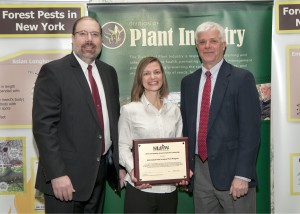
From left: Graham Cox, PhD., chair, Council of Forest Resource Organizations; Hilary Smith, APIPP director and NYS Department of Environmental Conservation Commissioner Joe Martens.
The Adirondack Park Invasive Plant Program (APIPP) received the 2013 National Invasive Species Awareness Week Award in the category of Outstanding Achievement in Invasive Species Leadership during a Forestry Awareness Day celebration at the Legislative Office Building in Albany on Tuesday, March 19.
This national recognition is for APIPP’s leadership in invasive species prevention and control, including collaboration and coalition building.
APIPP is a partnership program founded by The Nature Conservancy’s Adirondack Chapter, New York State Departments of Environmental Conservation (DEC) and Transportation (DOT) and New York State Adirondack Park Agency (APA).
“We are deeply honored by this recognition, which affirms the importance of local action and strong partnerships. With the extraordinary dedication of so many partners, collaborators, landowners and volunteers working together, we are making a difference to address tough challenges and know that solutions are within our grasp,” said APIPP Director Hilary Smith.
The first program of its kind in New York State, APIPP started in 1998 as a grassroots effort to implement a landscape-level approach to address threats posed by invasive species and minimize costs to governments, businesses and landowners.
It has since harnessed the energies of hundreds of volunteers, forged countless partnerships and influenced local and statewide action against invasive species.
APIPP served as the model for seven other programs, known as Partnerships for Regional Invasive Species Management (PRISM), now supported in large part through the state’s environmental protection fund.
Among APIPP’s initiatives that earned the group’s national recognition were the institution of early detection programs that brought hundreds of volunteers together to survey lands and waters to gather important baseline data to help identify priority areas for prevention and management.
The organization also provided free training to residents in forest pest detection, aquatic invasive species identification and invasive plant management techniques and helped to support boat launch stewardship programs that reach more than 30,000 recreationists per year.
Invasive species are a top threat to our lands and waters. Invasive animals and plants drive out native species and upset the food chain, ruin crops, degrade forests and fisheries, negatively impact recreation and can harm humans.
They typically come from other parts of the world and, in the absence of natural checks and balances, rapidly reproduce and spread.
Japanese knotweed, spiny water flea and Eurasian water milfoil are among the most threatening in the Adirondacks. Emerald ash borer, Asian longhorn beetle and hydrilla are nearby.
Researchers estimate invasive species cause environmental losses and damages of nearly $120 billion a year nationwide.
“The Adirondack Park Invasive Plant Program is an excellent example of how stakeholders with diverse responsibilities and interests can align on an issue of common ground to accomplish great things. APIPP is a most worthy recipient of this award,” said APA Chairwoman Leilani Ulrich.
